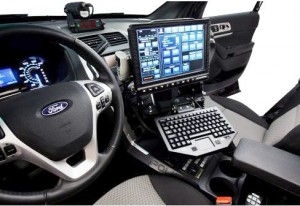
Ford was given the police market by default as GM exited. Now it's in for a real sales fight.
No, “UVs” in the headline is not a typo, and it doesn’t mean Ultra Violet, as in sunrays, either. But I confess I’m not sure whether to call Ford’s new Explorer an SUV (“Sport Utility Vehicle” as it has been for the last 20 years) or CUV (“Crossover Utility Vehicle,” meaning car-based as opposed to truck-based).
So I punted: just plain Utility Vehicle.
Ford punts, too, in its official release of the new Explorer-based 2012 Ford Police Interceptor Utility, announced today as a companion to the Taurus-based Ford Police Interceptor announced earlier as replacement for the venerable Crown Victoria Police Interceptor (CVPI) that ends production a year from now, next September.
Ever since Chevrolet abandoned building in Texas rear-wheel-drive V8 sedans at the end of the 1996 model run, the GM brand has tried to hold onto its share of the police market with another Chevy rear-drive V8, the Tahoe SUV for police service. Later it introduced a front-wheel-drive V6 Impala police vehicle, which has had modest acceptance, especially for urban and government police forces such as Park Rangers and MPs on Army bases, where its fuel economy appealed to cost-conscious fleet managers.
In the meantime, Ford police sales from the CVPI zoomed to 60% or more of the niche market, as noted in previous TDB accounts. But many police forces found the Chevy SUV police vehicle attractive for carrying K-9 pooches and for their general roominess so Ford’s domination was under pressure.
Despite equal opportunity regulations that have done away with size requirements for police hiring, cops are still mostly big guys with broad beams even before strapping on their pistol-radio-baton-ammo-cuffs-carrying belts. Importantly, on-board computers with full keyboards are now standard equipment in patrol cars, a development requiring center-front space hardly necessary 15 years ago. This has favored both CVPIs and SUVs, though special-purpose needs for the latter produces much smaller volume than for patrol sedans.
All this has led to Ford’s convenient new embrace of a UV for police sales, as it was for Chevrolet’s announcement last spring that it would offer a rear-drive V8 Caprice police-only sedan.
The other player in the police market, Dodge, has a new RWD V8 Charger sedan announcement coming before year-end—and I wonder if there isn’t a Jeep/Dodge/Ram police UV in the works?

Nearly 90% of the Police Interceptors' interior has been redesigned specifically for it.
So with all that background, what’s makes the Ford Police Interceptor Utility different from the civilian 2011 Explorer that the Dearborn company unveiled a few weeks ago?
To refresh your memory, the new Explorer is based on the Taurus/Lincoln MKS sedan, itself a Volvo derived platform, and will share production at Ford’s Chicago assembly plant.
It will be “unibodied” instead of truck-like body-on-frame, and powered by a 3.5-liter 260-horsepower V6 with no optional V8. Instead, it will offer an optional Ford Ecoboost 2.0-liter 237-horsepower I4 for remarkable fuel economy with alleged V6 performance. Ford claims the new Explorer V6 will offer a 20% gain in fuel economy vs. the V6 in the current truck-based Explorer, so the Ecoboost ought to be even better. Part of this comes from a six-speed automatic transmission finally making its way into all Ford passenger-based vehicles and some, er, truck-based units.
In addition the new Explorer in its standard form, like the sedans upon which it is based, is FWD with an optional 4WD rather than AWD option as in the cars. Since their inception, Explorers formerly were RWD with optional 4WD.
The 2012 Ford [Explorer] Police Interceptor Utility (FPIU) is not being announced with the Ecoboost I4 or Ecoboost V6 available, only the beefed-up standard V6, but it will have a choice of FWD or AWD. So you can see there is quite a difference in the respective powertrains between civilian and police vehicles. Further the FPIU’s souped-up V6 delivers “at least 280 horsepower” vs. 210 in 2010 Explorer V6.
Still, the FPIU also will “deliver at least 20% more fuel efficiency” than the CVPI V8. And like the Taurus-based police sedan, the FPIU has a column-mounted shift lever to free the floor-shift console for radio and computer equipment—an important feature for police service.
Given that SUVs traditionally tend to be top-heavy, a vital feature of the FPIU for police in emergency situations is Ford’s “corner control” technology, “designed to help drivers maintain control of their vehicles when taking curves at high speed.”
According to Ford’s statement, “Curve control senses when a vehicle is entering a curve too quickly, and can apply four-wheel ‘smart braking’ to reduce vehicle speed by up to 10 mph in approximately one second and help drivers follow their intended path.”
Otherwise, the Ford Utility police vehicle offers the full range of options and heavy-duty equipment available in the police sedan. A notable addition is a neat cabinet behind the rear seat, accessible with the tailgate open, with drawers and nooks for the kinds of stuff cops have to carry – say flares. Maybe even a water-dish spot for the K-9 pal.
Interestingly, the two new Ford police entries won’t be available for delivery until CVPI production at St. Thomas, Ontario, ends in September 2011, along with that of Lincoln Town Car.
Thus Ford’s marketing push will be to keep police fleet buyers from straying too far from the Ford family as they plan their purchasing budgets for the months ahead. It may be a tough sell, given ingrained police acceptance of the RWD V8 CVPI and the tough new competition, so there is speculation that many police forces will just hang on to their CVPIs as long as they can.
There’s always a taxi-fleet operator waiting for them anyway.
